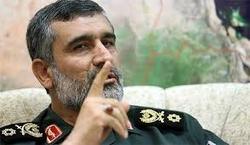 A top commander of Iran's Islamic Revolution Guards Corps (IRGC) says the US military bases in the region as well as its warships and other vessels are within reach of Iranian missiles up to a radius of 2,000 kilometers.
A top commander of Iran's Islamic Revolution Guards Corps (IRGC) says the US military bases in the region as well as its warships and other vessels are within reach of Iranian missiles up to a radius of 2,000 kilometers. RNA - Brigadier General Amir Ali Hajizadeh, the commander of the IRGC's Aerospace Division, made the remarks in a televised talk show on Sunday.
“In addition to US bases in the region, we have all their vessels, including aircraft carriers and warships, under fire of our missiles to a radius of 2,000 kilometers, and are constantly monitoring them,” the Iranian commander said.
He added, "They (Americans) thought that they could get out of our range of [missile] fire if they stand 400 kilometers away [from Iran's territorial waters]. However, no matter where they are, if a conflict is ignited, their warships will be first to be targeted by our fire."
In August, Hajizadeh said that Iran ranked first in the field of missile technology among the Middle Eastern countries and stood superior at a global level.
“Today, we rank first in the missile technology at the regional level and are placed among the few global powers in this regard,” he said.
Elsewhere in his Sunday remarks, the IRGC commander emphasized that the US is not in conditions, "but we are pessimistic about the future and are always ready for a the great war."
Hajizadeh also referred to shooting down of an intruding American spy drone by Iran's air defense forces over the country's southern coastal province of Hormozgan in June, saying it was done in defense of the country's airspace.
"We shot down [the American drone] though it had not intruded into our airspace more than a few kilometers. Even if it had entered [into Iran's airspace] a few meters, it would have still be shot down."
The IRGC said in a statement in June that the Global Hawk spy drone was brought down by its Aerospace Force near the Kouh-e Mobarak region, which sits in the central district of Jask County, after violating Iranian airspace
It added that the drone had stealthily continued on the route from the Strait of Hormuz towards Iran’s port city of Chabahar.
Hajizadeh dismissed Trump's claim about canceling an attack on Iran, saying that the American politicians and the Armed Forces might have debated this issue, but failed to reach a consensus.
"If they had done this [and attacked Iran], we would have targeted American bases by our missiles," the senior IRGC commander added.
He emphasized that the military bases of Al Udeid in the southwest of Doha, Qatar, Al Dhafra in the United Arab Emirates, and one of the American aircraft carriers positioned in the Sea of Oman and the Arabian Sea had been zeroed in on to be hit in case of a possible US attack on Iran.
The IRGC commander said neither Tehran nor Washington seek a war, but any "unwanted conflict may lead to a war."
In June, President Donald Trump said a US strike on three different Iranian sites would have killed 150 people but he cancelled it 10 minutes before the attack was going to be launched.
Trump warned that Iran’s decision to shoot down the US drone was “a big mistake,” and then reportedly approved military strikes against the country but pulled back after conferring with national security advisers and congressional leaders.
US Secretary of State Mike Pompeo on June 18 reiterated that President Trump does not seek war with Iran but Washington will continue to maintain its pressure campaign against the Islamic Republic.
Pompeo told reporters at MacDill Air Force Base in Florida that the American head of state did not want the conflict with Tehran to escalate, however, accused Iran of “aggression” and said the US military presence in the Middle East region was for protecting US interests.
847/940